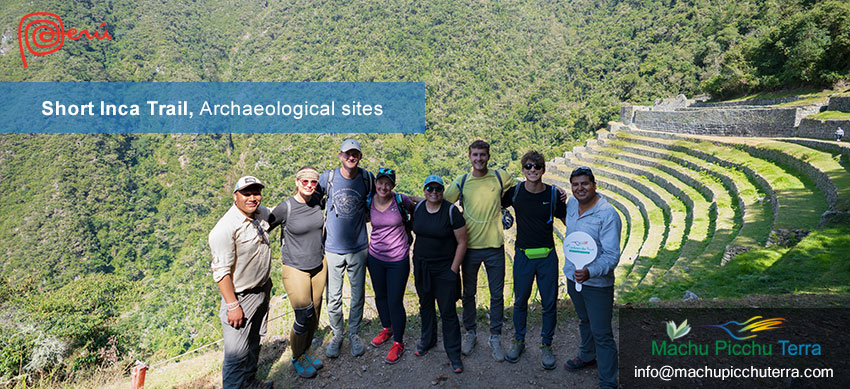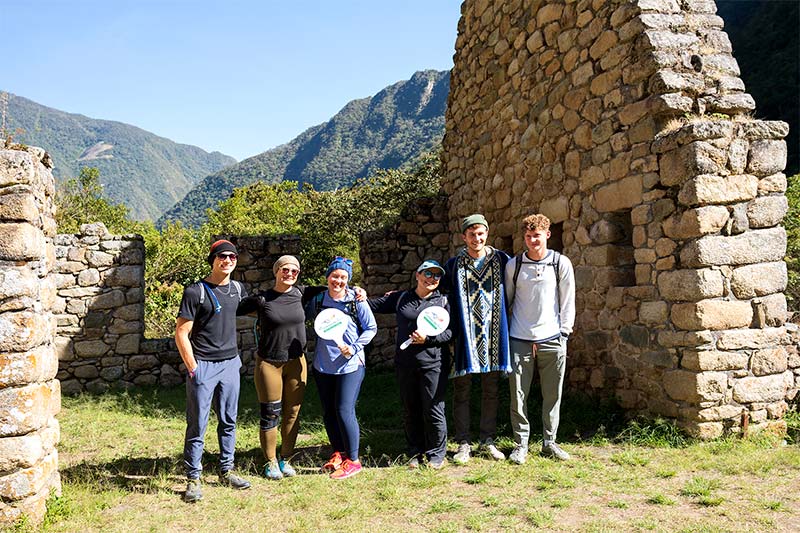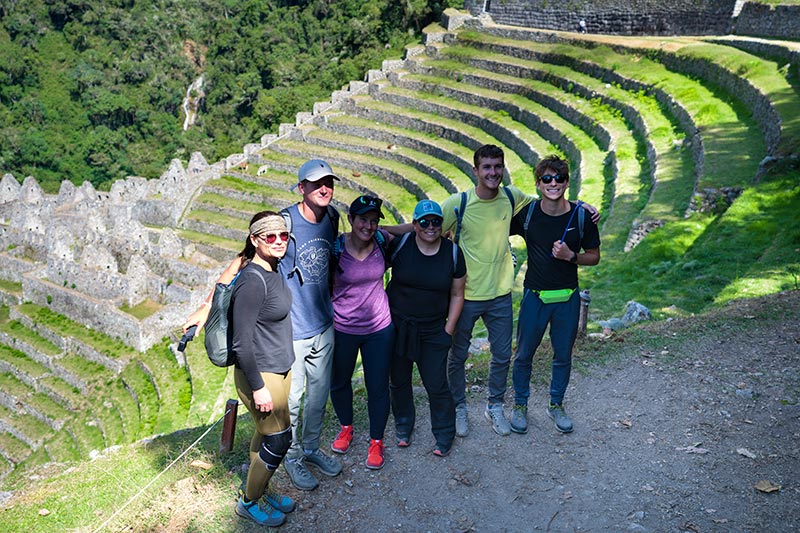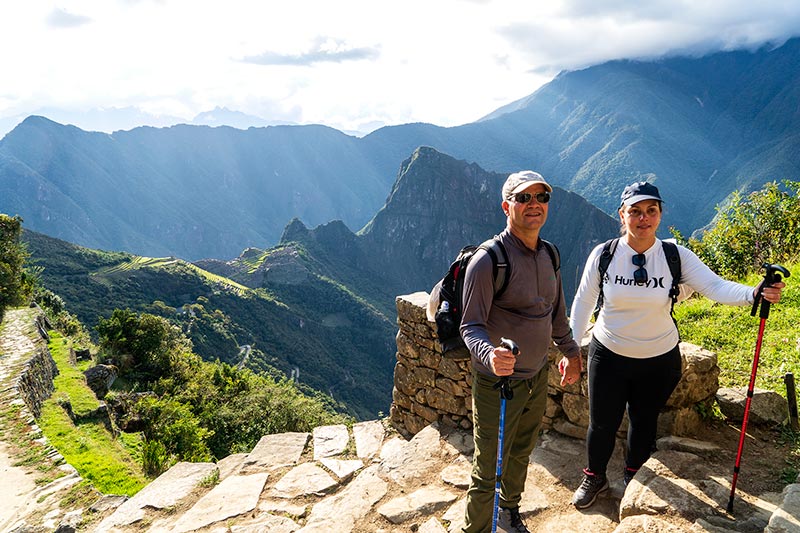
This route through the Inca Trails is often the best option to have a pleasant experience with the family. This is because this route only requires about 6 hours of walking, approximately. Many families are encouraged to take this tour in the company of children under 10 years old. Another positive factor of this tour is that you can see archaeological sites along the way. However, you cannot see as many of them as you would on the 4-day Classic Inca Trail. When doing this route, it is possible to find two amazing archaeological sites. For example, we will visit the imposing Wiñayhuayna and arrive at Machu Picchu through the Inti Punku or Sun Gate. At the same time, we will start the hike in Chachabamba.
The Short Inca Trail Route
This route is one of the best alternatives for those who want to know part of the Inca Trail to Machu Picchu. The Inca Trails, in general, are estimated to have had more than 60,000 kilometers of expansion. This entire route was designed to be traveled on foot for several days. In some sectors and at certain distances there were places to rest and to recover provisions. These roads served to intercommunicate all the constructions, sacred sites, and other places. It is believed that all these roads had Cusco as their starting point, from where the entire Qhapac Ñam, called in the Quechua language, began to branch out.
For all these reasons and thanks to the Peruvian Ministry of Culture. It was possible to recover part of these routes. Today they are known as the Inca Trail to Machu Picchu, You can also do, this hiking route safely and during much of the year. Only during February is the entrance prohibited so that these roads can undergo maintenance. This ensures that more people can visit throughout the years. In addition, only a limited number of people can enter daily. For this reason, the availabilities are exhausted almost immediately. This entire area is protected both to safeguard the archaeological sites and the variety of flora and fauna that can be found.
The Short Inca Trail to Machu Picchu has a duration of 2 days. It is a tour that allows you to visit archaeological sites and also to know part of these beautiful trails. Some of the sections that are crossed have the particularity of being paved, composed of stairs, or simply flat sections. However, the main particularity will be that they have beautiful views of the entire geography of the place. Likewise, it is possible to appreciate the change in the geography of the region, where the Andes are filled with abundant vegetation to give way to the high jungle.
The short Inca Trail to Machu Picchu begins as a traditional trip to the wonder of the world. That is, by taking a train ride. However, during the train ride, right at kilometer 104, those who have their ticket to the Short Inca Trail, get off the train and pass the checkpoint of Chachabamba. From there is where the hike begins and also where the first archaeological site can be seen. After the visit begins an uphill stretch, and then continue with a flatter trail to cross Wiñayhuayna and Inti Punku. From here you have one of the best views of Machu Picchu. These archaeological sites keep some mysteries that we will tell you below.
Chachabamba
Chachabamba is the first archaeological center that can be visited when doing the 2-day Short Inca Trail. To get to Chachabamba, just follow the trail that starts with the route to Machu Picchu. The average walking time is less than 15 minutes. As for the tour explanations of the guide can be extended for 30 minutes. The archaeological site of Chachabamba is of great proportions, but the area that can be visited is reduced.
Chachabamba seems to have been an important ceremonial center. This is because different constructions can be found with finely polished stone finishes. These polished stones are known or have the particularity of being recognized as the imperial type. This type of stone was only used in the most important sacred temples of Machu Picchu. An example of this type of stone can be found in the Coricancha in Cusco, in Pisac, Ollantaytambo, and even in other regions such as Ayacucho and Huanuco.
In addition to these finely polished stones for some constructions, an altar can be found that connects with a large stone. This altar is located near a small plaza that conforms to the construction. In addition, it was evidenced that Chachabamba has several water channels, all of them finely carved. These water channels seem to be the largest found about Inca constructions. In this sense, it is believed that Chachabamba was a place destined for the worship of water. This is also because it seems to have a close relationship with the snowy Salkantay that provides water from its thaws to much of the Antisuyo region.
The discovery of this archaeological site was made following the route of the Inca Trail in 1940 and 1941 by Paul Fejos. He was one of the first to notice the existence of water channels and some constructions that resemble water fountains. Although at the moment it is not possible to visit these places, it is important to understand the function it had during the heyday of Tawantinsuyo, because it seems to be a resting point, ideal for high officials and for the army. We hope to be able to appreciate more of this enigmatic place soon.
Wiñayhuayna
Wiñayhuayna is quite important for archaeologists. It is one of the Inca enclosures that were only abandoned but not destroyed during the Spanish invasion. Something similar to Machu Picchu and Choquequirao. Wiñayhuayana is a marvel of architecture and engineering created and designed by the Incas. It is located between the archaeological sites of Puyupatamarca and Intipunku. In this sense, it is one of the closest archaeological sites to Machu Picchu.
Wiñayhuayna will also serve as a break where hikers can have lunch and recover energy. This, of course, will take place in the camping area which is also a control point. At this point, it is also possible to meet with people who are doing the Inca Trail and for some reason were delayed or spend the night in the camp to start the hike at dawn.
From Wiñayhuayna to Inti Punku it is an average hike of 2 to 3 hours. This is at a good pace. But before that, it is possible to visit the archaeological site in its entirety. The arrival is made from the lower area of the platforms. So you have to climb the stairs and platforms to reach the upper area. In this place, you can find Inca constructions with finely carved stones or of the imperial type. The main characteristic of the sacred or religious constructions.
In Wiñayhuayna, we can find a series of constructions formed by water channels that surround the entire citadel. Also, a sector that could have housed important ceremonial constructions. That is why it is called the House of the Inca. Further to the left at the top you can find a construction similar to the Temple of the Sun in Machu Picchu. It is also called a tower because of its semicircular construction. In this sense, it would represent an important construction of great religious and vital value for the population of those years.
Inti Punku
The Inti Punku as such is not a citadel or important ceremonial center as in the previous cases. However, it receives the name of Inti Punku, which can be translated from Quechua as “The door of the Sun”. Suppose we think about the important value that the Sun represents as a deity for the Incas. We could say that it is a valuable construction. However, as such, it does not seem to cover that range. We mention this because it does not have finely carved stones for its walls.
On the other hand, the Inti Punku seems to be designed more as a checkpoint. The Inti Punku connects the rest of the Inca Trail with the rest of the route or the Inca Trail leading to Machu Picchu. Strictly speaking, it would fulfill this role. It also offers one of the most beautiful views of Machu Picchu. Getting to this place by doing the Inca Trail, in any of its variations is one of the best activities that can be done by the fascinating geographical change and first view or impression it offers of Machu Picchu.
The Inti Punku is located one hour from Machu Picchu Picchu, formerly you could make some tours or ascents to this place. You only needed to carry the entrance ticket to Machu Picchu Solo, but nowadays this route is prohibited. Fortunately, it is still possible to reach this place by doing the 4-day Classic Inca Trail or the Short Inca Trail, which only requires a one-day hike to reach Machu Picchu. However, the tour as such for the entire llaqta of Machu Picchu will take place on the second day in the case of the short route. However, on the traditional route, you can appreciate the sunrise and how some of the sun’s rays are reaching the citadel.
What else can we find?
During the Short Inca Trail option, you may encounter different surprises. One of these will be the mosquitoes, especially in Chachabamba. In this sense, we recommend the use of mosquito repellent. However, it is possible to see other insects of regular size, some of them will have particular colors. It is possible to find more of these animals, especially during the entrance to the high jungle or when passing through Wiñayhuayna.
Similarly, you can find some species of birds endemic to Machu Picchu. For this, you have to be very lucky because it is even possible to find the legendary cock of the rock, the national bird of Peru. Sightings of more birds and other animals have also been reported. To find these animals you have to be attentive and somehow have experience to achieve this activity. However, what is a spectacle is the change of geography that is experienced and also the beautiful and unique views of Machu Picchu.
By Inca Trail Machu Picchu - Last updated, 15-03-2024
Interested in the Inca Trail? Know more about Archaeological sites!
- Huamanmarca or Wamanmarca archaeological site
- Inca Bridges on the Inca Trail
- The most important sacred temples of Machu Picchu
- Qoriwayrachina archaeological site
- Runkurakay archaeological site
- Sayacmarca archaeological site




